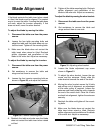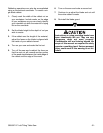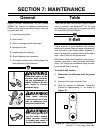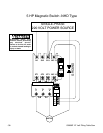
-30- G5959Z 12" Left-Tilting Table Saw
Figure 40. Sacrificial fence.
This table saw can also be used to cut L-shaped
rabbets. These cuts can be created with a regu-
lar saw blade or with dado blades.
Proper rabbet operations will differ depending on
the blade system you choose. Consult the
instructions included with your dado blades for
directions regarding attachment and adjustment.
To use a dado blade for rabbeting operations:
1. Disconnect the table saw from the power
source.
2. Rabbet cutting on the edge of a piece of
stock requires the use of a wooden sacrifi-
cial fence that is as long as the metal fence
and
3
⁄4" thick as shown in Figure 40. Attach
the sacrificial fence to the metal fence with
screws or clamps, making sure they are all
secure and tight.
Rabbet Operations
5. If rabbeting along the length of your work-
piece, adjust the distance between the fence
and the outside edge of the blade to suit your
needs as shown in Figure 41. When cutting
across the wood grain, use the miter gauge
as a guide while rabbeting. Remember:
Never use the fence as a stop in conjunction
with your miter gauge.
6. Using a scrap as a test piece, switch on the
saw and take a pass over the dado blade.
7. If the cut is satisfactory, repeat with your fin-
ish stock.
8. Re-install the blade guard.
Always use push sticks, featherboards,
push paddles and other safety accessories
whenever possible to increase safety and
control during operations which require
that the blade guard and splitter must be
removed from the saw. ALWAYS replace the
blade guard after dadoing is complete.
Figure 41. Rabbet cutting.
Rip Fence
Rip Fence
Sacrificial Fence
Sacrificial Fence
Blade
Cut-Out
Dado Insert
3. Remove the table insert, splitter guard and
the regular saw blade from the arbor.
4. Attach and adjust the dado blade system as
recommended in the dado blade instructions.
Raise the blade system according to your
needs. Make sure it will not cut through the
workpiece.
Workpiece
Dado Blade


















